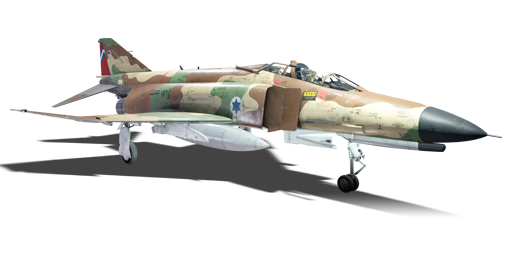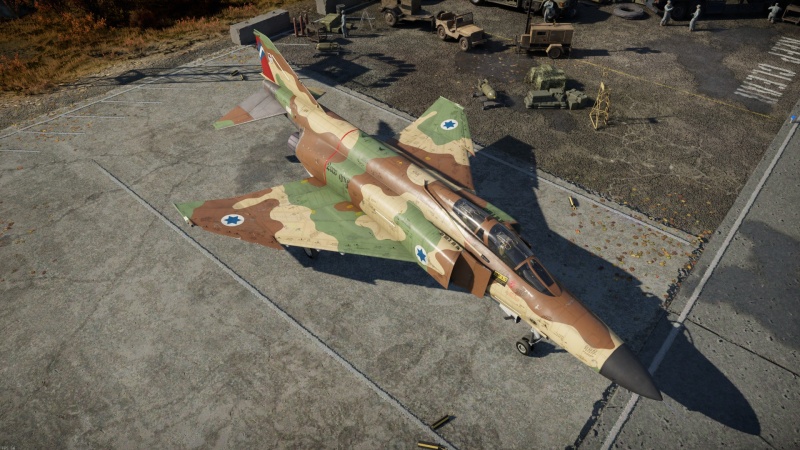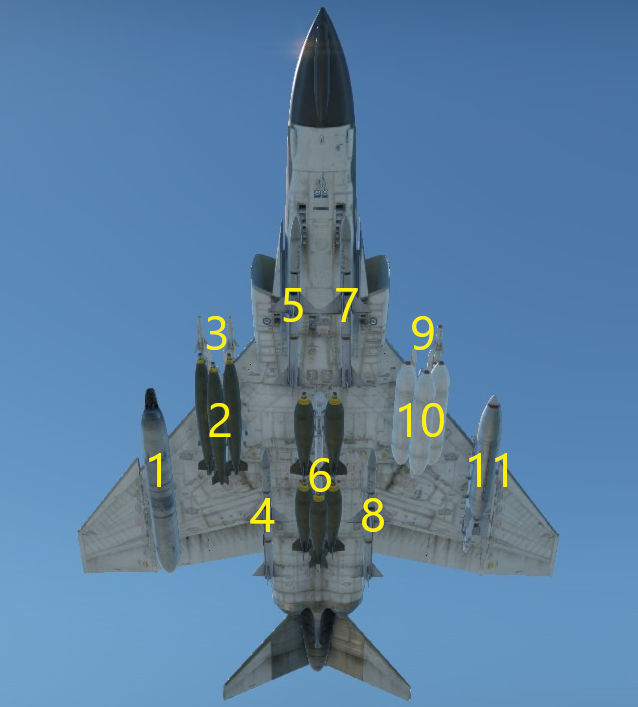Kurnass 2000
| This page is about the Israeli jet fighter Kurnass 2000. For the other version, see Kurnass. |
Contents
Description
The F-4E Kurnass 2000 is a rank VIII Israeli jet fighter with a battle rating of 12.0 (AB/SB) and 12.3 (RB). It was introduced in Update "Sky Guardians".
General info
Flight performance
| Characteristics | Max speed (km/h at 12,192 m) |
Max altitude (metres) |
Turn time (seconds) |
Rate of climb (metres/second) |
Take-off run (metres) | |||
|---|---|---|---|---|---|---|---|---|
| AB | RB | AB | RB | AB | RB | |||
| Stock | 2,065 | 2,039 | 16000 | 26.5 | 27.5 | 160.6 | 150.9 | 850 |
| Upgraded | 2,202 | 2,140 | 25.5 | 26.0 | 221.6 | 190.0 | ||
Details
| Features | |||||
|---|---|---|---|---|---|
| Combat flaps | Take-off flaps | Landing flaps | Air brakes | Arrestor gear | Drogue chute |
| ✓ | ✓ | ✓ | ✓ | ✓ | ✓ |
| Limits | ||||||
|---|---|---|---|---|---|---|
| Wings (km/h) | Gear (km/h) | Flaps (km/h) | Max Static G | |||
| Combat | Take-off | Landing | + | - | ||
| 1458 | 463 | 1,458 | 625 | 463 | ~11 | ~4 |
| Optimal velocities (km/h) | |||
|---|---|---|---|
| Ailerons | Rudder | Elevators | Radiator |
| < 810 | < 750 | < 700 | - |
Engine performance
| Engine | Aircraft mass | |||||
|---|---|---|---|---|---|---|
| Engine name | Number | Basic mass | Wing loading (full fuel) | |||
| General Electric J79-GE-17 | 2 | 14,205 kg | 408 kg/m2 | |||
| Engine characteristics | Mass with fuel (no weapons load) | Max Gross Weight | ||||
| Weight (each) | Type | 9m fuel | 20m fuel | 30m fuel | ||
| 1,750 kg | Afterburning axial-flow turbojet | 15,964 kg | 18,027 kg | 20,070 kg | 27,501 kg | |
| Maximum engine thrust @ 0 m (RB/SB) | Thrust to weight ratio @ 0 m (WEP) | |||||
| Condition | 100% | WEP | 9m fuel | 20m fuel | 30m fuel | MGW |
| Stationary | 5,200 kgf | 8,008 kgf | 1.00 | 0.89 | 0.80 | 0.58 |
| Optimal | 5,260 kgf (1,458 km/h) |
10,170 kgf (1,400 km/h) |
1.27 | 1.13 | 1.01 | 0.74 |
Survivability and armour
Examine the survivability of the aircraft. Note how vulnerable the structure is and how secure the pilot is, whether the fuel tanks are armoured, etc. Describe the armour, if there is any, and also mention the vulnerability of other critical aircraft systems.
Modifications and economy
Armaments
| Ballistic Computer | ||||
|---|---|---|---|---|
| CCIP (Guns) | CCIP (Rockets) | CCIP (Bombs) | CCRP (Bombs) | Lead indicator |
| |
|
|
|
|
Offensive armament
The Kurnass 2000 is armed with:
- A choice between two presets:
- 1 x 20 mm M61A1 cannon, chin-mounted (640 rpg)
- 1 x 20 mm M61A1 cannon + 90 x countermeasures
Suspended armament
The Kurnass 2000 can be outfitted with the following ordnance presets:
- Without load
- 2 x AIM-9G Sidewinder missiles
- 6 x AIM-9G Sidewinder missiles
- 6 x AIM-9L Sidewinder missiles
- 3 x 20 mm GAU-4 cannons (1,200 rpg = 3,600 total)
- 24 x 250 lb LDGP Mk 81 bombs (6,000 lb total)
- 24 x 500 lb LDGP Mk 82 bombs (12,000 lb total)
- 17 x 750 lb M117 cone 45 bombs (12,750 lb total)
- 4 x BLU-27/B incendiary bombs
- 13 x 1,000 lb LDGP Mk 83 bombs (13,000 lb total)
- 3 x 2,000 lb LDGP Mk 84 bombs (6,000 lb total)
- 285 x FFAR Mighty Mouse rockets
- 60 x Zuni Mk32 Mod 0 ATAP rockets
- 4 x AIM-7E-2 Sparrow missiles
- 4 x AIM-7F Sparrow missiles
- 144 x countermeasures
- 6 x AGM-65D missiles
- 4 x 277 kg GBU-12 Paveway II bombs (1,108 kg total)
- 4 x 957 kg GBU-10 Paveway II bombs (3,828 kg total)
Custom loadout options
| 1 | 2 | 3 | 4 | 5 | 6 | 7 | 8 | 9 | 10 | 11 | ||
|---|---|---|---|---|---|---|---|---|---|---|---|---|
| 20 mm GAU-4 cannons (1,200 rpg) | 1 | 1 | 1 | |||||||||
| 250 lb LDGP Mk 81 bombs | 6 | 3 | 6 | 3 | 6 | |||||||
| 500 lb LDGP Mk 82 bombs | 6 | 3 | 6 | 3 | 6 | |||||||
| 750 lb M117 cone 45 bombs | 3 | 3 | 5 | 3 | 3 | |||||||
| 1,000 lb LDGP Mk 83 bombs | 2 | 3 | 3 | 3 | 2 | |||||||
| 2,000 lb LDGP Mk 84 bombs | 1 | 1 | 1 | |||||||||
| BLU-27/B incendiary bombs | 1 | 2 | 1 | |||||||||
| 277 kg GBU-12 Paveway II bombs | 2*† | 2*† | ||||||||||
| 957 kg GBU-10 Paveway II bombs | 1*† | 1*† | 1*† | 1*† | ||||||||
| FFAR Mighty Mouse rockets | 57 | 57 | 57 | 57 | 57 | |||||||
| Zuni Mk32 Mod 0 ATAP rockets | 12 | 12 | 12 | 12 | 12 | |||||||
| AGM-65D missiles | 3† | 3† | ||||||||||
| AIM-7E-2 Sparrow missiles | 1‡ | 1 | 1 | 1‡ | ||||||||
| AIM-7F Sparrow missiles | 1‡ | 1 | 1 | 1‡ | ||||||||
| AIM-9G Sidewinder missiles | 2† | 1‡ | 1‡ | 2† | ||||||||
| AIM-9L Sidewinder missiles | 2† | 1‡ | 1‡ | 2† | ||||||||
| Countermeasures | 72 | 72 | ||||||||||
| Pave Spike targeting pod | 1* | |||||||||||
| Maximum permissible loadout weight: 7,257 kg Maximum permissible weight imbalance: 1,500 kg | ||||||||||||
| * Pave Spike targeting pod must be equipped when carrying guided bombs † AGM-65D missiles on hardpoints 2/10 cannot be equipped in conjunction with guided bombs, or Sidewinders on hardpoints 3/9 respectively ‡ Sparrows on hardpoints 4/8 cannot be carried in conjunction with Sidewinders on hardpoints 5/7 respectively | ||||||||||||
Usage in battles
Air RB:
In Air RB, the Kurnass 2000 could be compared to the F-4EJ Kai, having the same air-to-air missile armament and similar radar. To properly utilize the 8 potent missiles and one of the best radars in game is the major task that every Kurnass 2000 pilot will have to face. Typically, enter the battle at a low altitude and shooting down everyone on your way is a viable and effective way to fly the Kurnass 2000. Climbing could also be attempted, but given the presence of AIM-54s and 4th generation fighter jets featuring the same avionics and significantly higher climb rate, it would be a riskier style to fly the Kurnass 2000.
A major difference between the Kurnass 2000 and the F-4EJ Kai is the slats on the Kurnass' wings. At high speed, extension of the slats provides more lift and limits the angle of attack of the aircraft, resulting in a significant decrease in speed loss during turns to a level even comparable to the level of 4th generation aircraft like the F-16 and MiG-29. At lower speed, the slats also increase the overall manoeuvrability of the aircraft, so it is advised to extend the slats in battles (by toggling "combat flaps"), especially when fighting in groups, retracting them when needed to gain more speed or for higher angle of attack. Overall, the slats of the Kurnass provides pilots with the ability to alter the aerodynamics of the aircraft during combat, and provide more versatility and a higher overall performance compared to the F-4EJ Kai.
Pros and cons
Pros:
- One of the most effective air-to-air armament sets in-game with AN/APG-76, AIM-7Fs, and AIM-9Ls
- Wing slats for increased manoeuvrability and versatility
- High level of manoeuvrability at high speed as with any other Phantoms
- Guided bombs and missile with targeting pod for engaging ground targets
Cons:
- Big and heavy aircraft
- Thrust to weight ratio less than 4th generation jets
History
Kurnas 2000, which entered service in the IAF on April 9th 1989, was different from the original Phantom mostly in its avionics. "Although they look practically identical, the Kurnas 2000 is a completely different plane", said Lt. Col. A., commander of a Phantom squadron, who was being interviewed by the IAF Magazine. "The avionics make it a completely new aircraft. The avionics are, in effect, the heart of the plane, and the upgrading project basically amounted to a heart transplant; the Phantom's heart was replaced with a much stronger one".
The conversion plan included replacing the plane's original radar with a new one. Norden, an American company, developed the APG-76 radar especially for this purpose - and according to the IAF's specifications. This radar, considered to be the best of its kind, uses advanced technologies that were originally developed for the US Navy's future attack plane, the A-12 Avenger II - a project that has since been cancelled.
The APG is a Synthetic Aperture Multi-Mission Radar System which constructs a representation of the terrain by sending electromagnetic waves towards it. The great advantage of this mode of operation, compared with systems that are based on optical equipment, is that the picture quality remains good, even in bad weather. The radar is currently an exclusive feature of the Kurnas 2000, but in view of its superb performance, the USAF is considering a special pod mounted version for its F-16's.
The Kurnas 2000 also boasts a Kaiser wide-angle heads-up display, considered the best in the world. The wide angle means that the system effectively covers 60% of the pilot's forward view - twice the angle covered by other systems. The displays, located directly in front of the pilot, show vital measurements like speed, altitude, direction of flight, etc., as well as information regarding the operation of weapons systems.
The multifunction displays are one of the most important improvements in the Kurnas 2000's cockpit. The WSO, who is in charge of operating the planes avionics and weapon systems, sees the data pertaining to both systems on two color displays. A screen in the forward section of the cockpit shows the pilot the information he needs, and can be toggled to mirror the WSO's screen.
The multifunction displays greatly improve cockpit ergonomics, and ease much of the work burden on the two crew members - especially during combat operations.
Media
- Skins
- Videos
See also
- Related development
External links
Paste links to sources and external resources, such as:
- topic on the official game forum;
- other literature.
| Israel jet aircraft | |
|---|---|
| Kfir Canard · Kfir C.2 · Kfir C.7 · Nesher | |
| Britain | |
| Meteor | Meteor NF.13 · Meteor F.8 |
| France | |
| Vautour | Vautour IIA · Vautour IIN |
| Super Mystere | Sambad · Sa'ar |
| Mirage III | Shahak |
| Other | M.D.450B Ouragan · Mystere IVA |
| USA | |
| F-84 | F-84F |
| A-4 | A-4H · A-4E Early (M) · A-4E · Ayit |
| F-4 | Kurnass · Kurnass 2000 |
| F-15 | Baz · Baz Meshupar · F-15I Ra’am |
| F-16 | Netz · F-16C Barak II · F-16D Barak II |






